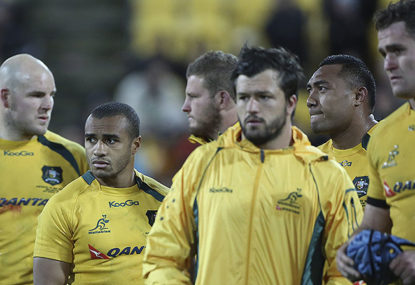At present, Australian rugby union stocks are slipping. A toxic coach-replacement process brought out diatribe and division, about the very fabric of Australian rugby.
A near-loss to Argentina in Perth was hailed as cause for celebration. In the next Test between the Pumas and Wallabies, in Rosario, it is very difficult to assign an underdog tag.
Recently, the Wallabies were put to the sword by the British and Irish Lions, the All Blacks, and the Springboks, in a manner that suggested clear inferiority in forward play, and a lack of direction and purpose in backline play.
We need Australia strong. Innovative, nationalistic, clever, and athletic, the Aussies bring a welcome flair to Southern Hemisphere rugby. Added to the bruising style of the Springboks (and now Pumas), the bar-bouncer assault of the Samoans, Fijians, and Tongans, and the brutally efficient All Black juggernaut, Australian rugby can be a cheeky antidote, where handling skills, high-ball acrobatics, and all manner of kicks can add intrigue.
Australian rugby is woven into the tapestry of Union history. In 1883, the rugby community of New South Wales sent a team on the first tour by any rugby club or nation, beyond its borders.
They went to New Zealand, and then received a New Zealand team the next year. Australia reached out, and sent rugby players, at a time when centralized electricity was just becoming a reality in Europe.
There was nothing easy about travel in those days. Telephones had only come into Sydney in 1881. Even the notion of a rugby tour had a distinctly brave air. New Zealand had about 500,000 inhabitants. It was “at the end of the earth”.
But the Aussies have a particularly global view, as a Commonwealth nation that grew wealthy and connected, commercially and militarily. In 1899, a British team played four Tests in Australia, three in Sydney and one in Brisbane. This opened up a massive, defining characteristic of Union: the tours, the Tests, the global scope.
If Rugby League had not formed and taken hold in 1907, there is no doubt that Australia’s role in Union would have been even greater. But history cannot be recuperated; Union was seen as the “Northern” game. And the World Wars hit Australian contact sports hard.
There were glory days. In 1953, Aussie Captain John Solomon was carried off the Newlands pitch to a standing ovation of Capetonian fans who had seen a 14-18 defeat of the Boks – their first defeat in 15 years.
There have been the two World Cup victories. The magic of Lynagh and Campese. The brilliance of the Wallaby attack. The pluck they showed in Wellington in 2011 (Bryce Lawrence’s incompetence aside, Australia showed heart).
But nowadays, the malaise that ails OZ seems basic. They do not go forward enough, their runners are not supported, they seem unable to maintain continuity, and against really good teams, they seem unable to exert pressure.
Wallaby ball carriers do not get in front of the rest of their fellow Wallabies as soon as possible after winning the ball. They do not consistently cross the gain line at a rate to trouble their opposition and enable teammates to run at a retreating defence.
The Wallabies – under Deans or Link–do not misshape the defence to create attacking space in which play makers can create situations that allow penetrators and support runners to go forward at speed. When did we last see a Wallaby No. 8 perform a quickly executed pick-up at the base of the scrum?
A Test forward may handle the ball five or six times; if very busy, ten to fifteen times. Oz is not making those touches count. And when a Wallaby player is not handling the ball, what are their running and realignment patterns? None are apparent.
Also, the Wallabies appear deluded on their runs; they seem to either believe they cannot beat any defender or that they will beat all the defenders. This does not test any well-organized defence.
Also, this Oz iteration does not consistently control the space between it, either on attack or defence. Against SA, I did not see Oz deny the Boks space to act and time to think. In fact, the score should have been much worse.
But more than anything, I see Australia failing to tackle their opponents as far behind their gain line as possible. Pocock was the last Wallaby I’ve seen drive a big ball carrier backwards in the tackle.
Hooper is hungry but small, and does not hunt the ball with cohorts. Hunting in numbers is all New Zealand does.
A word about fitness. Oz looks lean and fast. But part of rugby fitness is more akin to wrestling. It’s “ground” speed. Getting back up. Fast. Oz does not keep as many players on their feet as possible.
Plus, Hooper chases lost causes and gets taken out of plays. So does Mowen.
The fix is to return to basics. And cut anyone who won’t work. Folau and O’Connor may be talented, but I’d cut Folau for not running back on Jean de Villiers’ try in Brisbane, and I think the cut of O’Connor, even though he is the only Aussie who might crack a match-day All Black or Bok side, is good for team morale. He’ll come back chastened and better for it – or not at all.





























































































